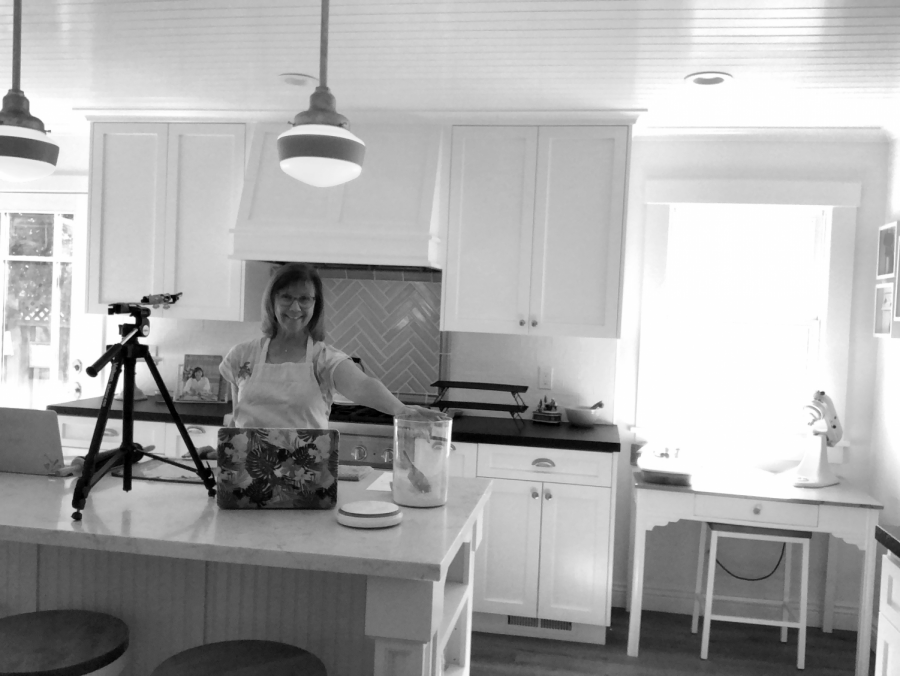DISTANCE LEARNING: Teaching from home
Culinary teacher Kathy Hopp demonstrates a recipe for her students from her kitchen at home via Google Meet.
The 2020-2021 school year took a turn when SCUSD announced that the first semester of school would be online due to COVID-19. Teachers like Culinary arts teacher Kathy Hopp have had to adjust their lesson plans and familiar teaching styles in preparation for the school year.
Hopp said she was disappointed but understands SCUSD’s decision regarding distance learning.
“I mean that’s why I teach (in-person). It’s to be around the students, not to look at them one inch tall on my screen,” Hopp said.
Hopp is not the only teacher dissatisfied by distance learning.
“I hate it,” English teacher Elizabeth Kelly said. “I hate it because I really love being with my students, you know? I just want to be with everybody.”
Many teachers share similar feelings.
“I personally would appreciate teaching in person a million times more now that we’ve been put in this situation,” social science teacher Chima Ikeme said.
Teachers have been faced with struggles and continue to learn as they go through the school year.
“I would very much prefer, based on my experience so far, to be in person,” science and AVID 11 teacher Ian Martin-Fodor said. “It’s a whole new experience that they didn’t really teach us a whole lot about in teachers’ school, so it’s been a learning process, but I’m surviving.”
Not being able to physically interact with students has generated problems for some teachers in terms of both social and educational success. Many feel they cannot easily make connections or get to know students through a screen.
“I mean interaction is the biggest thing, but that goes along with interacting in class, how I’m teaching and the content that I give, so all that encompasses and interactions are the biggest difference,” Ikeme said.
Additionally, without the ability to see or hear students without them having to press a button, teachers do not know if students understand the lesson, or if they need more help.
“I can’t just walk up to their desk and see what their paper looks like or what they’re looking at. I can’t point to it for them,” Martin-Fodor said. “So I really have to be as clear as I can and give the students time to ask questions so that I can try to figure out what they need help with.”
Teachers also have to be understanding of internet problems, according to Ikeme. Instead of just worrying about potential student struggles with their subject material, teachers now must worry about the added layer of poor internet.
“If you have a strong internet connection, or your house has a better internet connection, then you are probably doing better than a student who doesn’t have that strong internet connection because that’s one more thing that you don’t have to worry about,” Ikeme said.
Along with internet issues, teachers like Kelly realize that their students may be struggling with this new learning environment.
“Distance learning demands that you are a self-regulated learner,” Kelly said. “You’re self-motivated, and you’re able to be organized and keep track of stuff … and doing it online when people aren’t right there to help you or check stuff … it’s pretty rough.”
Even with the downsides of distance learning, some teachers have had opportunities to collaborate with other teachers in a way they may not have under normal circumstances, brainstorming ways to introduce their subjects in this new online environment.
“It has been very helpful to share ideas with other teachers like that,” Hopp said. “It’s helped me come up with some things that I’m actually really excited about and we wouldn’t do in any other circumstance.”
Culinary arts teachers in the district are not the only ones who have come together.
“I have way more time to collaborate with other teachers who are teaching the same stuff I am, and that has been hugely helpful because it is easy to not do that in face-to-face (learning),” Kelly said.
But even with all the challenges, opportunities and disappointments that distance learning has presented, most teachers understand the situation and why distance learning is necessary.
“In a normal world, I would say I really hate it. I miss the kids,” Hopp said. “But in a world with COVID and all of the health dangers out there, I feel grateful that our district is keeping everyone healthy and safe at home.”


